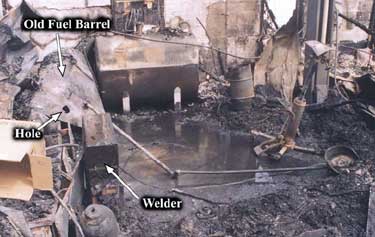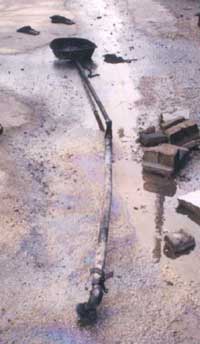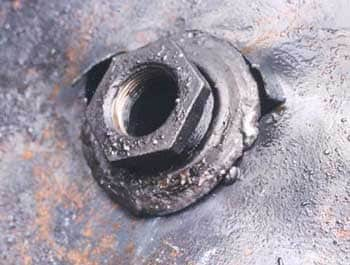Auto Mechanic Dies from Explosion While Welding a Barrel in His Shop
Iowa Case Report: 03IA045
Report Date: August 4, 2004
Summary
During the summer of 2003, a 40-year-old male auto mechanic was fatally injured in an explosion at his auto repair shop. His two employees had left about ten minutes earlier, and he was the only one working in the building at the time. He was repairing an old 250 gallon barrel that was used to hold waste motor oil. He had constructed a system to drain used motor oil from cars to the waste oil barrel. This system had an articulated arm made of one-inch steel pipe, an oil pan attached to one end, and an adjustable support rig in the other end. The pipe connected into a bung hole on top of the barrel, and was supported by a bungee cord attached to the vehicle being worked on. Over time, the attachment point of the pipe to the fuel barrel became broken, and the victim was welding this area on the fuel barrel when the explosion occurred. The victim had changed oil on a car earlier that day, and fresh used oil (laden with gasoline fumes) was in the waste oil barrel. Sparks from the welder ignited the fumes in the oil barrel causing it to explode, and it sprayed burning oil all over the shop area and the victim. He was seen running out of the burning building, being himself on fire from head to foot. A neighbor rushed to his aid and covered him with a blanket, and the man was rushed to a local hospital, which immediately transferred him to a regional burn center. The mechanic suffered 3rd degree burns over 90% of his body and inhalation burns, and he died within a few hours. The auto repair shop was completely destroyed by the fire.
 |
|
Photo 1 – View of the burned out shop area, showing the old fuel barrel and welder.
|
Recommendations based on our investigation are as follows:
- Special procedures must be followed when welding containers.
Introduction
During the summer of 2003, a 40-year-old auto mechanic was killed in an explosion at his auto repair shop. The Iowa FACE program was notified of this incident by local news, and began an investigation. Information was gathered from newspapers, a local TV news service, the county Sheriff, the State Fire Marshall, and interviews with the victim’s wife and one employee. Photographs and video of the scene were also obtained. A site visit was not conducted.
The victim was self-employed as an auto mechanic, and had two employees at the time. He had been in business for eight years, and had over 20 years of experience in auto repair. This business offered basic auto repair services for a small community in Iowa. The business had been at its present location for the past four years. Two employees, both mechanics, had been working at the shop that day, but had left the shop ten minutes before the explosion. There was no official safety program or written policies in this small business. The victim had periodically reminded workers of hazards associated with the tools and products they were using.
Investigation
This auto repair shop had built a system for collecting used engine oil from vehicles. The oil was stored in an old 250 gallon fuel barrel, as seen in Photograph 1. This barrel had a bung hole on the top side and a welded pipe fitting connected to an articulated arm made of one-inch steel pipe. The other end of the pipe had a welded oil pan for collecting used oil (see Photo 2). When a vehicle needed its oil changed, it was raised off the ground with a hydraulic lift, and the oil pan was positioned under the engine oil drain plug. The oil pan and articulated arm were held in place under the vehicle with a simple bungee cord.
Recently, one employee did not use the bungee cord, and the weight of the articulated arm cracked the weld around the hole on the oil tank. The employee was told to repair the tank, and his plan was to drain the barrel of oil and fill it with water before he began welding. Apparently, at this time the employee had a vacation already scheduled, and he didn’t have time to repair the barrel before he left, but was planning to do so when he returned to work. The victim, however, was unwilling to wait until that time, and being the owner of the shop, chose to repair the used oil barrel himself. The barrel had broken once before in the same location, and the victim had successfully repaired it at that time without any problems.
 |
|
Photo 2 – Articulated pipe with oil pan on one end, and broken fitting for the oil barrel on the other.
|
The victim was working alone, using a wire-feed welder. He had made one tack point on the barrel. When he began welding on the cracked area, the barrel exploded. The end of the barrel blew out, and the victim and his shop were instantly engulfed in burning waste oil. Neighbors heard the large explosion and rushed to help. The victim was seen running out of the shop, completely covered with burning oil, and a neighbor threw a blanket around him. The victim was conscious and talking, and was quickly transported to a local hospital and flown to a regional medical center’s burn unit. His burn injuries were severe, with 3rd degree burns on 90% of his body, including inhalation damage. He died a few hours later. The auto repair business was completely destroyed in the ensuing fire.
Fire investigators learned that the man had changed oil on a vehicle that morning, and that the barrel contained fresh used oil, which usually contains dissolved volatile components. It is assumed that fresh gasoline vapors in the oil tank ignited, causing the explosion. Over time, these vapors will dissipate if the container has access to open air. This may explain why the victim was able to weld the barrel at one point previously without incident.
 |
|
Photo 3 – Close-up of bung hole showing broken welds that were being repaired.
|
Cause of Death
The cause of death taken from the medical examiner’s report was, “shock, due to 92% total body surface burns with inhalation burns, due to explosion”. An autopsy was performed.
Recommendations/Discussion
Recommendation #1 Special procedures must be followed when welding containers.
Discussion: 29CFR1910.252 describes specific safety procedures for welding. These
procedures include removing and taking all movable fire hazards in the vicinity to a safe place, protecting all combustible materials from sparks, having fire extinguishers readily available, using fire watchers if there are combustible materials close to the point of operation, and inspecting the area and authorizing the work before welding. Welding is prohibited in the presence of explosive atmospheres (mixtures of flammable gases, vapors, liquids, or dusts with air) or atmospheres that may develop inside un-cleaned or improperly prepared tanks, which have previously contained such materials. Specific regulations for welding or cutting containers state that no welding or cutting or other hot work shall be performed on used drums, barrels, tanks, or other containers until they have been cleaned so thoroughly as to make absolutely certain that there are no flammable materials present. The containers must be vented, and purging with inert gas is recommended.
Several aforementioned safety precautions were violated in this case. While used vehicle oil typically has a low vapor pressure, and is not perceived to be explosive, it can contain volatile compounds and is clearly included in the materials for which all of the above precautions apply. Fresh used oil from a vehicle will usually contain some amount of gasoline or other volatile compounds, which will vaporize in the container where the used oil is stored, creating an explosion hazard. The victim had conducted a similar welding repair before without incident. Apparently, the vapors that time were not at explosive levels. It is likely that the victim was aware of the hazard, as the repair had been discussed with the employee before. The victim may have considered the risk, his earlier experience, and the fact that draining, cleaning, and purging this oil barrel was not a quick and simple task.
There have been many similar reports of explosions from welding on used oil drums, fuel tanks, gas barrels, etc. Even when empty, these containers may retain an explosive mixture, which can explode from welding sparks. Any containers must be thoroughly drained, cleaned, and vented (and preferably purged with inert gas) before welding or cutting.
Iowa FACE Program
FACE is an occupational fatality investigation and surveillance program of the National Institute for Occupational Safety and Health (NIOSH). In the state of Iowa, The University of Iowa, in conjunction with the Iowa Department of Public Health carries out the FACE program. The NIOSH head office in Morgantown, West Virginia, carries out an intramural FACE program and funds state based programs in Alaska, California, Iowa, Kentucky, Massachusetts, Michigan, Minnesota, Nebraska, New Jersey, New York, Oklahoma, Oregon, Washington, West Virginia, and Wisconsin.
The purpose of FACE is to identify all occupational fatalities in the participating states, conduct indepth investigations on specific types of fatalities, and make recommendations regarding prevention. NIOSH collects this information nationally and publishes reports and Alerts, which are disseminated widely to the involved industries. NIOSH FACE publications are available from the NIOSH Distribution Center (1-800-35NIOSH).
Iowa FACE publishes case reports, one page Warnings, and articles in trade journals. Most of this information is posted on our web site listed below. Copies of the reports and Warnings are available by contacting our offices in Iowa City, IA.
The Iowa FACE team consists of the following from the University of Iowa: Craig Zwerling, MD, PhD, MPH, Principal Investigator; Wayne Johnson, MD, Chief Investigator; John Lundell, MA, Coordinator; Risto Rautiainen, PhD, Co-Investigator, Martin L. Jones, PhD, CIH, CSP, Co-Investigator, and John Kraemer, PA. From the Office of The State Medical Examiner.
To contact Iowa State FACE program personnel regarding State-based FACE reports, please use information listed on the Contact Sheet on the NIOSH FACE web site Please contact In-house FACE program personnel regarding In-house FACE reports and to gain assistance when State-FACE program personnel cannot be reached.

